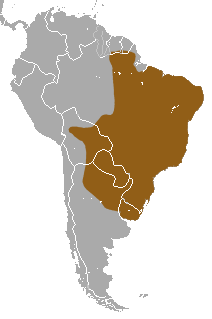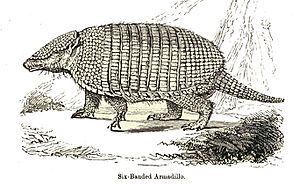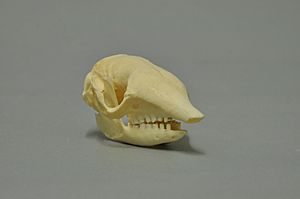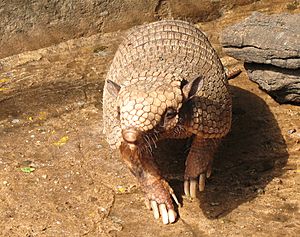Six-banded armadillo facts for kids
Quick facts for kids Six-banded armadillo |
|
|---|---|
 |
|
| In the Pantanal, Brazil | |
| Conservation status | |
| Scientific classification | |
| Genus: |
Euphractus
|
| Species: |
sexcinctus
|
 |
|
| Range of the six-banded armadillo | |
| Synonyms | |
|
List
Dasypus encoubert Desmarest, 1822
Dasypus flavipes G. Fischer, 1814 Dasypus sexcinctus Linnaeus, 1758 Loricatus flavimanus Desmarest, 1804 Scleropleura bruneti Milne-Edwards, 1872 Tatus sexcinctus Schinz, 1824 Euphractus hexcinctus |
|
The six-banded armadillo (Euphractus sexcinctus), also known as the yellow armadillo, is a cool animal found in South America. It's the only living member of its group, Euphractus. A scientist named Carl Linnaeus first described it in 1758.
This armadillo is usually about 40 to 50 centimeters (16 to 20 inches) long, not counting its tail. It weighs between 3.2 and 6.5 kilograms (7 to 14 pounds). Its hard shell, called a carapace, can be pale yellow to reddish-brown. It has small, bristle-like hairs on it. Its front feet have five toes, each with strong claws for digging.
Six-banded armadillos are great at digging. They make burrows to live in and to find food. They are usually alone and are very alert. These armadillos eat many different things, like insects, ants, dead animals (called carrion), and plants. They have poor eyesight, so they use their strong sense of smell to find food and avoid danger. Baby armadillos can be born any time of year. They stay in their mother's womb for about 60 to 64 days. Usually, one to three babies are born at a time. They stop drinking milk at one month old and are grown up by nine months.
You can find the six-banded armadillo in many places. These include savannas (grasslands), forests, and shrublands. They are quite common. Their home stretches from Brazil and Suriname in the north, all the way down to Bolivia, Paraguay, Uruguay, and northern Argentina. The International Union for Conservation of Nature (IUCN) says they are of "least concern". This means they are not in danger of disappearing.
Contents
What is a Six-Banded Armadillo?
The six-banded armadillo is the only animal in its group, called Euphractus. It belongs to the Chlamyphoridae family. It was first described by Carl Linnaeus in 1758. He called it Dasypus sexcinctus back then. Scientists have found old bones of Euphractus armadillos from long ago in Brazil, Argentina, and Bolivia. These bones are from the Pleistocene era.
There are five different types, or subspecies, of the six-banded armadillo:
- E. s. boliviae: Found in a region called Gran Chaco in Brazil.
- E. s. flavimanus: Lives in Mato Grosso (Brazil), eastern Paraguay, Uruguay, and northeastern Argentina.
- E. s. setosus: Found in the very southeastern part of Brazil.
- E. s. sexcinctus: Lives in southeastern Brazil.
- E. s. tucumanus: Found in Catamarca and Tucumán Provinces in Argentina.
The six-banded armadillo is different from other armadillos in its group. It has a narrow head. It also has six to seven movable bands on its hard shell, the carapace. People also call it the 'yellow armadillo'. In Portuguese, it's known as tatu peludo or tatu peba.
How to Identify a Six-Banded Armadillo

The six-banded armadillo is the biggest armadillo in its group. It's actually the third largest armadillo overall! Only the giant armadillo and the greater long-nosed armadillo are bigger.
These armadillos are usually 40 to 50 centimeters (16 to 20 inches) long from head to body. They weigh about 3.2 to 6.5 kilograms (7 to 14 pounds). Their shell is pale yellow to reddish-brown. It's covered with scales that are all the same length. You'll see some light, bristle-like hairs on the shell. Unlike some other armadillos, they don't have very dense hair. The shell gets narrower near their head. Their head is covered with plates in a clear pattern.
Their front feet have five toes. Each toe has a claw that helps them dig. The third claw is the longest. Their ears are about 32 to 47 millimeters (1.3 to 1.9 inches) long. They have strong teeth and muscles for chewing. Their tail is 12 to 24 centimeters (4.7 to 9.4 inches) long. It has two to four bands of plates on the underside. Some of these plates have tiny holes for special scent glands. This is a unique feature!
Life and Behavior
Scientists have different ideas about when six-banded armadillos are most active. Some say they are active during the day (diurnal). Others say they are active at night (nocturnal). They are very alert animals. If they sense danger, they usually run away. But if you try to handle them, they might bite!
These armadillos mostly live alone. They only get together to eat dead animals. One study found that an armadillo's home area can be about 93.3 hectares (230 acres).
They are excellent diggers. They can dig U-shaped burrows with just one opening. They usually dig these burrows in dry areas. These burrows can be deep and help them find food. The burrows of six-banded armadillos are about 19 centimeters (7.5 inches) high and 21 centimeters (8.3 inches) wide at the entrance. They get narrower inside. As they dig, they use their front feet to loosen the soil and their back feet to push it out behind them.
What They Eat
The six-banded armadillo is an omnivore. This means it eats both plants and animals. They eat dead animals, small bugs, insects, and ants. They also enjoy fruits (especially from bromeliad plants), palm nuts, and tubers (underground plant parts). One study even called them "carnivore-omnivores." In some areas, plants are a big part of their diet. Armadillos in zoos have even been seen eating large rats!
Since they don't see very well, armadillos use their amazing sense of smell to find food. They also use it to sniff out predators. To eat their prey, they stand on it, grab it with their teeth, and tear it into pieces. Six-banded armadillos can store fat under their skin. This helps them survive when food is hard to find. This fat can make them weigh up to 8 to 11 kilograms (18 to 24 pounds)!
Reproduction and Life Cycle
Six-banded armadillos can have babies all year round. After being pregnant for 60 to 64 days, the mother gives birth to one to three babies. Each newborn weighs about 95 to 110 grams (3.4 to 3.9 ounces). Their shell is soft and has no hair when they are born. They can make soft clicking sounds.
The pregnant mother builds a nest before her babies arrive. If she feels disturbed, she might get aggressive and move her babies to a new spot. The babies' eyes are closed at birth. They open when the babies are about 22 to 25 days old. They stop drinking milk at one month old. By nine months, they are fully grown. Some armadillos have lived for almost 18 years!
Where They Live
The six-banded armadillo lives in many different places. These include savannas (grassy plains), old forests, new forests, cerrados (a type of grassland), shrublands, and deciduous forests (forests where trees lose leaves). They are very good at adapting to different homes. You can even find them on farms! They have been seen as high as 1,600 meters (5,200 feet) above sea level.
One study in Brazil found about 0.14 armadillos per hectare (about 2.5 acres). This study also showed that six-banded armadillos often share their space with southern naked-tail armadillos. They sometimes move out of each other's way, which helps them live together.
These armadillos are found across a large part of South America. Their range goes from Brazil and southern Suriname in the northeast. It then spreads through Bolivia, Paraguay, and Uruguay, all the way to northern Argentina in the southeast. It's not clear if they live in Peru.
Threats and How We Protect Them
The IUCN says the six-banded armadillo is of "least concern". This is because they live in many places, can handle different environments, and there are lots of them. Plus, they live in many protected areas.
Even though there are no big threats to their survival, some groups of armadillos might be decreasing. This is happening north of the Amazon River. There are fewer savannas there, and more people are building homes and factories. Also, people sometimes hunt these armadillos for traditional medicine.
Six-banded armadillos sometimes go into farm fields to eat young plants. Farmers might use traps with corn to catch them and stop them from damaging crops.
Images for kids
See also
 In Spanish: Armadillo amarillo para niños
In Spanish: Armadillo amarillo para niños











